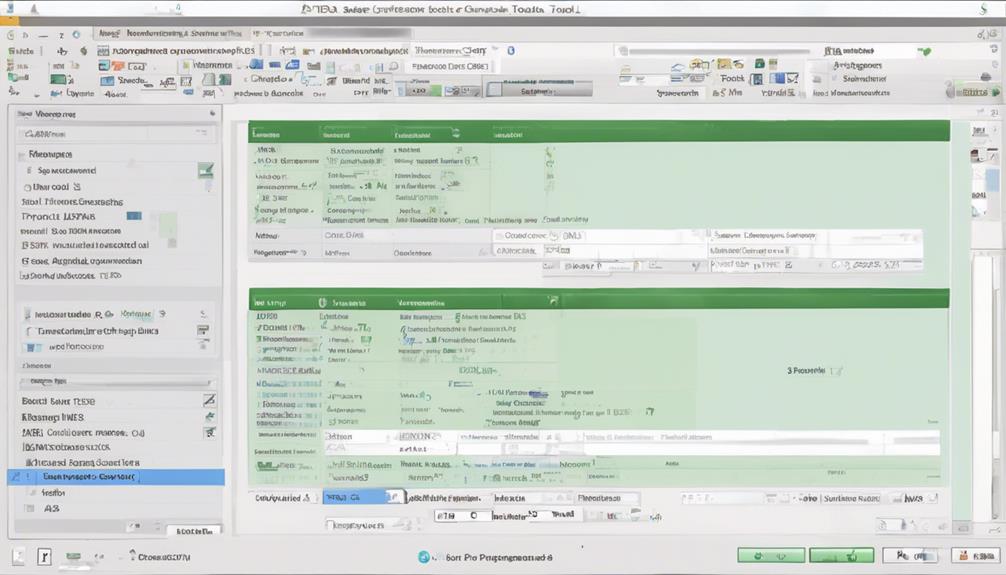Regarding bulk data formatting services, did you know that handling large data volumes efficiently is just the tip of the iceberg? From diverse data formats to real-time processing demands, many challenges in bulk data formatting services await. As you navigate through the complexities of data accuracy, security, and transformation, each hurdle presents an opportunity to enhance your expertise in this dynamic field. Explore the top 10 challenges that professionals in bulk data formatting services encounter daily, and discover how overcoming these obstacles can lead to unparalleled success in the data formatting realm.
Handling Large Data Volumes
When managing bulk data formatting services, one of the primary challenges that often arises is the task of handling large data volumes. To address this challenge effectively, utilizing data compression techniques can be paramount. By compressing data, you can reduce the amount of storage space required, making it easier to manage and transfer large volumes of data efficiently. Additionally, implementing data deduplication methods can further optimize the handling of large data volumes. Data deduplication eliminates redundant copies of data, ensuring that only unique information is stored. This not only helps in reducing storage requirements but also streamlines data processing tasks by minimizing the amount of data that needs to be processed. When dealing with substantial amounts of data, employing these techniques can significantly enhance the overall performance and effectiveness of bulk data formatting services.
Dealing With Diverse Data Formats
When dealing with diverse data formats, you will encounter challenges related to the complexity of various formats, making it difficult to ensure seamless integration with existing systems. Standardization becomes a crucial aspect as you navigate through the intricacies of different data structures and schemas. Addressing these issues effectively is key to streamlining bulk data formatting services and optimizing data processing workflows.
Data Format Complexity
Navigating through the realm of bulk data formatting services, you are confronted with the intricate challenge of data format complexity. Within this intricate landscape, data mapping challenges emerge as a significant hurdle. Data mapping involves translating data fields from one format to another, requiring meticulous attention to detail to ensure accuracy and consistency.
One of the key obstacles faced in data format complexity is maintaining formatting consistency across various data types and structures. Different data formats may have unique requirements, such as varying field lengths, data types, or encoding standards. Ensuring that the data is correctly formatted according to these specifications can be a daunting task, especially when dealing with large volumes of data.
To overcome the challenges presented by data format complexity, it is essential to implement robust data mapping processes and tools that facilitate seamless transitions between different formats. By addressing formatting inconsistencies and mapping challenges proactively, organizations can streamline their data formatting services and enhance overall efficiency.
Integration With Systems
Integrating diverse data formats into existing systems poses a formidable challenge in the realm of bulk data formatting services. This task requires meticulous attention to system compatibility and efficient data synchronization to ensure smooth operations. When dealing with varied data formats, several key challenges arise:
- Interoperability Concerns: Ensuring that different data formats can seamlessly communicate and integrate with one another within the existing systems can be complex and time-consuming.
- Data Mapping Complexity: Mapping data fields from diverse formats to fit the structure of the target system requires precision and accuracy to prevent data loss or corruption.
- Real-time Integration Needs: Maintaining data synchronization in real-time across systems with divergent formats demands robust mechanisms to handle updates promptly and accurately.
Addressing these challenges necessitates a deep understanding of system architectures, data structures, and robust integration strategies to ensure a seamless and efficient data flow within the bulk data formatting services.
Standardization Challenges
To navigate the complexities of bulk data formatting services, particularly in the realm of integrating diverse data formats, one must be prepared to confront the formidable challenge of standardization. Data standardization strategies play a crucial role in addressing this challenge by establishing uniformity across varied data formats. By implementing consistent naming conventions, data structures, and formatting guidelines, organizations can streamline data processing and enhance overall data quality.
The benefits of data standardization are manifold. Firstly, it facilitates seamless data integration, enabling disparate systems to communicate effectively. Standardization also simplifies data analysis and reporting by ensuring that all data elements are structured consistently. Moreover, standardized data enhances data governance practices, as it becomes easier to enforce data quality controls and maintain data integrity. By adhering to robust data standardization strategies, organizations can optimize their data processing workflows, minimize errors, and derive greater insights from their data assets.
Ensuring Data Accuracy
To ensure data accuracy in bulk data formatting services, it is imperative to establish robust quality control measures that can effectively identify and rectify any discrepancies. Data validation and quality control play a crucial role in maintaining the integrity of the information processed. Here are three key strategies for ensuring data accuracy:
- Implement automated data validation tools to check for inconsistencies and errors in the data.
- Conduct regular audits and reviews to verify the accuracy of the formatted data and address any issues promptly.
- Provide training to staff involved in the data formatting process to ensure they understand the importance of accuracy and are equipped to handle data effectively.
Maintaining Data Security
Maintaining data security is a critical aspect of bulk data formatting services, as safeguarding sensitive information from unauthorized access or breaches is paramount in today’s digital landscape. Data encryption plays a key role in protecting data integrity during transmission and storage. By encoding data into a secure format, it becomes unreadable to unauthorized users, ensuring confidentiality. Additionally, implementing robust access control mechanisms is essential to restrict data access based on user roles and permissions. This helps prevent unauthorized users from viewing or modifying sensitive information within the dataset.
Effective data security measures not only involve encryption and access control but also necessitate regular security audits and updates to identify and address vulnerabilities promptly. By staying proactive and vigilant, you can mitigate potential risks and enhance the overall security posture of your bulk data formatting services. Remember, prioritizing data security is crucial to maintaining trust with clients and stakeholders, safeguarding valuable information from malicious threats.
Achieving Real-Time Data Processing
To achieve real-time data processing, speed is crucial in handling large volumes of information efficiently. Automation plays a significant role in streamlining processes and reducing manual intervention, leading to improved accuracy and quicker response times. By prioritizing speed and implementing automated systems, organizations can enhance their data processing capabilities and stay ahead in today’s fast-paced digital landscape.
Speed in Data Processing
Speed in data processing is a critical aspect of achieving real-time data processing in bulk data formatting services. To enhance the speed of data processing, consider the following strategies:
- Utilize Data Compression Techniques: Implement efficient data compression methods to reduce the size of the data being processed, leading to quicker processing times and reduced storage requirements.
- Implement Parallel Processing Strategies: Divide the data processing tasks into smaller subtasks and execute them simultaneously using parallel processing techniques. This approach can significantly accelerate the overall data processing speed.
- Optimize Resource Allocation: Ensure that computational resources such as CPU, memory, and storage are allocated effectively to avoid bottlenecks and maximize processing speed. Proper resource optimization can lead to faster data processing and improved efficiency.
Automation for Efficiency
Enhancing efficiency through automation is pivotal in achieving real-time data processing within bulk data formatting services. Automation streamlines repetitive tasks, such as data validation and error handling, by reducing the need for manual intervention and ensuring swift processing. By implementing automated processes, you can significantly decrease the time required to format large volumes of data accurately.
Data validation plays a crucial role in ensuring the accuracy and integrity of the information being processed. Automated validation routines can swiftly identify discrepancies, inconsistencies, or missing data points, allowing for immediate corrective actions to be taken. This proactive approach enhances the overall quality of the formatted data and reduces the likelihood of errors slipping through the cracks.
Error handling is another area where automation excels. Automated error detection mechanisms can quickly flag any issues during the data processing stage, enabling prompt resolution before further processing occurs. By addressing errors in real-time, you can prevent data corruption and maintain the reliability of the formatted data. Automating error handling processes ensures a smoother data processing flow and enhances the efficiency of bulk data formatting services.
Integrating Data From Various Sources
Efficiently integrating data from various sources is a critical aspect of bulk data formatting services. This process involves combining information from different origins to create a unified and coherent dataset. To achieve successful data integration, consider the following key points:
- Data mapping: Establish clear mappings between the fields of data coming from diverse sources. Consistent data mapping ensures that information is correctly matched and organized during the integration process.
- Data extraction: Utilize efficient data extraction methods to gather information from multiple sources. Proper data extraction techniques help in retrieving the necessary data accurately and promptly.
- Standardization: Implement standardization processes to ensure that data from various sources adhere to a unified format. Consistent standards facilitate smooth integration and enhance the overall quality of the formatted data.
Improving Data Quality
To enhance the overall effectiveness of bulk data formatting services, prioritizing the improvement of data quality is paramount. Data validation plays a crucial role in ensuring that the information being processed is accurate and consistent. By implementing robust validation processes, errors and inconsistencies can be identified and rectified promptly, leading to higher data quality standards.
Additionally, data enrichment is essential for enhancing the value of the information being processed. Through data enrichment techniques, such as adding missing information, correcting errors, and eliminating duplicates, the overall quality and completeness of the data can be significantly improved. This not only enhances the reliability of the data but also enables better decision-making processes based on enriched and accurate information.
Optimizing Data Transformation Processes
A key aspect crucial to the success of bulk data formatting services is the optimization of data transformation processes. Efficient handling of data transformation is essential for achieving accurate results and maintaining workflow efficiency. To enhance this optimization, consider the following:
- Data Transformation Optimization: Implement algorithms and techniques that streamline the transformation of raw data into a structured format. Utilize tools that can automate repetitive tasks and improve the overall speed of the transformation process.
- Performance Metrics: Establish clear performance metrics to measure the effectiveness of data transformation processes. Monitor key indicators such as processing time, error rates, and throughput to identify areas for improvement and ensure consistent quality output.
- Streamlining Transformation Processes: Identify and eliminate bottlenecks in the data transformation workflow. Simplify complex steps, reduce unnecessary dependencies, and optimize the sequence of operations to enhance overall efficiency and productivity.
Dealing With Complex Data Structures
Streamlining data transformation processes efficiently can lead to significant improvements in workflow productivity. When dealing with complex data structures, data modeling plays a crucial role in understanding and representing the relationships between different data elements. By creating a clear data model, you can better grasp the intricacies of the information you are working with and develop a structured approach to handling it.
Data normalization is another key aspect when managing complex data structures. Normalizing data involves organizing it in a structured manner to reduce redundancy and improve data integrity. This process ensures that each piece of information is stored in the most efficient and logical manner, making it easier to retrieve and analyze when needed.
To effectively deal with complex data structures, it is essential to invest time in designing a comprehensive data model and implementing data normalization techniques. These practices can streamline your data transformation processes and enhance the overall efficiency of your workflow.
Managing Data Redundancies
Managing data redundancies is a critical aspect of ensuring data integrity and efficiency in data processing. To effectively tackle this challenge, consider the following strategies:
- Redundancy reduction strategies: Implementing automated tools or algorithms to identify and eliminate duplicate entries can significantly enhance data quality and streamline processing workflows.
- Data duplication management: Establishing robust protocols for detecting and resolving data duplicates promptly is essential for maintaining the accuracy and consistency of information stored within a dataset.
- Data normalization techniques: Applying normalization techniques such as standardizing data formats or values across different fields can help reduce inconsistencies and redundancies, facilitating smoother data processing operations.
Frequently Asked Questions
How Can I Ensure Data Privacy During Bulk Data Formatting?
To ensure data privacy during bulk data formatting, you can implement data encryption to protect sensitive information. Access control mechanisms can also be utilized to restrict unauthorized access, enhancing the security of your data processing operations.
What Are the Best Practices for Handling Data Quality Issues?
When handling data quality issues, remember that 2% of errors can lead to 80% of data problems. Implement data cleansing techniques like duplicate removal and use data validation methods such as regular expressions for accuracy.
How Do I Address Data Consistency Across Multiple Sources?
To address data consistency across multiple sources, begin by aggregating data from all sources. Next, validate the data to ensure accuracy and uniformity. This systematic approach helps maintain consistency and reliability in your data processing.
Can Real-Time Data Processing Be Achieved Without Compromising Accuracy?
You can achieve real-time accuracy without compromising accuracy by implementing robust data validation mechanisms. Ensure data integrity through constant monitoring and quality checks. Preserve privacy protection by adhering to stringent security protocols and encryption standards.
What Tools Are Recommended for Optimizing Data Transformation Processes?
To optimize data transformation processes, consider utilizing data mapping tools and automation strategies. These tools can streamline the conversion of data formats and enhance efficiency in managing bulk data. Stay organized and efficient with these solutions.



